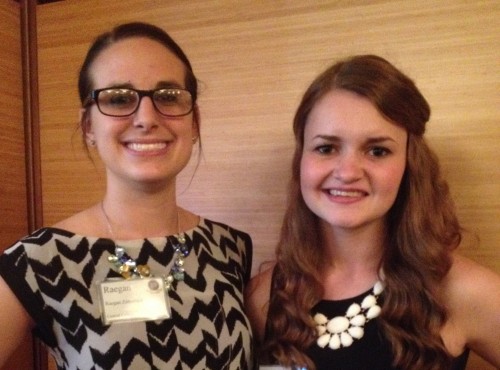
Elizabeth Carman ’15 and Raegan Zetterlund ’16, communication studies majors at Central College, presented original research on smartphones and families at the Iowa Communication Association conference on Sept. 19. Their paper was recognized as the top undergraduate submission.
by Jenni Hodges
Something was missing, three Central College students noticed, when they read recent studies on technology and families. “We didn’t see anything about smartphones,” Raegan Zetterlund ’16 said.
Zetterlund, Elizabeth Carman ’15 and Jake Mollman ’14 were in assistant professor of communication studies Shelley Bradfield’s course on technology and human communication—and with this observation, they found their topic for original research.
Bradfield required all her students to create their own data for the course. Her goal was to challenge students to conduct new research, Bradfield said, and provide experience that would make graduate school more accessible.
Early in the spring semester, Bradfield also encouraged Carman, Mollman and Zetterlund to submit their work to the Iowa Communication Association. Carman and Zetterlund, communication studies majors from Jefferson and Keokuk, Iowa, presented their group work at the state conference on Sept. 19 (Mollman graduated in May). Their paper, “Smartphone Effects on Family Cohesion,” was recognized as the top undergraduate submission.
So, are smartphones good or bad for families? According to Carman and Zetterlund, the threats and benefits depend on the user. “What’s interesting about our research,” Carman said, “is that it’s not conclusive.”
Instead of showing smartphones to be primarily harmful or beneficial, the students’ research indicated that different ways of using smartphones determine their positive and negative effects. For example, families may benefit when they use smartphones for GPS or sharing everyday events. On the other hand, members may also use smartphones as distractions, creating conflict within their families.
In such cases, the students emphasized that smartphones are not themselves to blame for hindering family connection. “Is it the device?” Zetterlund asked. “Or is it that people are choosing to focus on their devices rather than on each other?”
However prevalent this kind of distraction may be, the students also found that most participants monitored and limited their use of smartphones while with their families.
Zetterlund, who wants to become a professor or media analyst, said it was exciting to see how her coursework connected with the real world in this research. Carman also said the project was a unique opportunity. “They were the best group members I’ve ever had,” she said of Zetterlund and Mollman.
According to Bradfield, the students’ research not only fills a gap in previous studies, but also strikes an appropriate contrast by focusing on the users of this technology. “It’s not technology-centric,” Bradfield said. “That’s cutting edge.”
